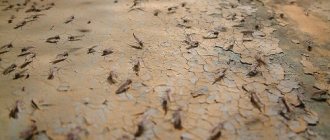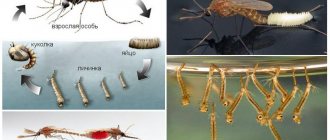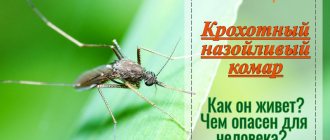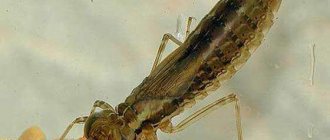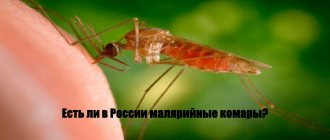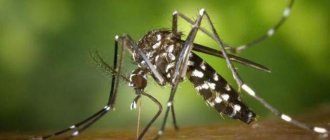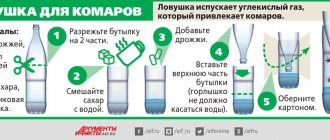Why do they bite us and how does this affect mosquito reproduction?
The fact is that human sweat contains lactic acid; bloodsuckers sense it at a great distance. For this reason, mosquitoes torment people most severely during the hot season. Being bitten, people, without knowing it, encourage the reproduction of mosquitoes and create very comfortable conditions for them. Thanks to the saturation of mosquito females with blood, a new population of viable and strong individuals appears.
Not everyone knows, but mosquitoes reproduce even if they do not bite people or animals. In this case, they have to expend the resources of their own body to form eggs. As a result, the offspring of mosquitoes are born weak, and after laying the insect itself dies. Until the time of laying comes, the female constantly returns to the victim and bites her, after each digestion of blood.
In order to get rid of mosquitoes, you need to start with the original cause of the nuisance: reproduction. Understanding how mating occurs and what individuals eat will help you choose the right place to travel. And avoid many problems. Mosquitoes are harmful to humans, and to effectively combat them, it is helpful to first learn how mosquitoes reproduce.
Mosquito mating process
- The ideal place for mating is a stagnant body of water; the males accumulate near them and wait for the female.
- Females emit a thin squeak, thereby attracting males, who feel it with the help of their antennae; they make this characteristic sound with their wings.
- Individuals gather in a swarm in which only male mosquitoes move, they drag the female into it and mating occurs.
- The female who finds herself inside the swarm is fertilized by the male mosquito who first grabbed her.
The process lasts a very short time, at the end the mosquito returns to the other males. The internal genital organs are hidden in the body of the mosquito; in females these are the ovaries and ovipositor, in the form of a short tube, and in males these are the testes. Fertilization also occurs internally; during sexual intercourse, mosquito sperm enters the female, into her reproductive tract.
Life cycle of a larva
The development of mosquito larvae can occur at temperatures from +10 to +35⁰С, optimal values are +25…+30⁰С. The larvae that have just emerged from the eggs are very small, their size is 1-2 mm. They grow quickly, increasing in size 10 times or more. The weight of insects during this time increases 400–500 times.
During development, the larva goes through 4 molts. After each of them, the insect becomes larger, and the system of internal organs becomes more complex. After the fourth molt, the larva turns into a pupa, from which an adult mosquito will subsequently emerge in the form familiar to humans - with wings and legs.
What happens after the female is fertilized?
The female mosquito feeds on the blood of mammals very actively, as this is required by the process of development and formation of eggs. The male does not have special piercing bristles inside his proboscis, so he remains a vegetarian. With the oral apparatus of a male individual it is simply impossible to bite. In females, the oral apparatus is fully formed, they penetrate the skin and inject into it a special secretion that prevents blood clotting. After mating, females lay eggs on the surface of the water.
There are two ways in which females lay eggs:
- Separately, one egg at a time
- “Packs” of eggs glued together.
Their number is usually from 150 to 400. Female mosquitoes can lay about 1200 eggs during their entire life span. After the breeding process, the male mosquito dies. Females lay eggs every 2-3 days during the active period.
A brief introduction to insects
Mosquitoes (other “official” names are true or blood-sucking mosquitoes) - from the point of view of biological classification, they are the family Culicidae, assigned to the group of Long-whiskers and the order of Diptera insects, which are characterized by sexual reproduction and complete transformation (metamorphoses from egg to adult: o These will be discussed in detail below).
Adult female mosquitoes drink human blood and are part of the midges - a group of blood-sucking insects, for which they have earned strong dislike from people
Mosquitoes are small flying insects. The length of their thin and soft body varies from 4 mm to 15 mm in different species. All representatives of the family Culicidae are characterized by the presence of long legs, which end in 2 claws for better grip on surfaces and stability, and narrow transparent wings, consisting of many caps. Their span ranges from 5 mm for the smallest species to 30 mm.
In tropical regions there are real giants: for example, long-legged mosquitoes, or caramors, in favorable conditions they grow up to 10 cm in length, which is a record figure.
Most species of the Mosquito family have a nondescript color: gray, brown, yellow. Much less often (and mainly in southern countries) black or green specimens are found. The thoracic region of insects is wider than the abdomen. The long antennae, necessary for orienting the insect in space, are formed by 15 segments.
The mosquito's mouthparts are a piercing-sucking type. It is hidden in the lower lip of the insect, which is shaped like a tube. Inside it are sharp jaw stilettos, similar to blades. They are needed to cut a microscopic hole in the skin, through which the sucking proboscis then penetrates to the layer of capillaries. Moreover, in females it consists of piercing bristles, which are absent in males.
By the word “mosquito,” people most often mean the squeaky mosquito. It is he who annoys people with his obsessive buzzing and painful bites.
In total, the Mosquito family has 3,000 species, divided into 38 genera. Most of them live in southern countries with a tropical climate. Only 100 species, representing 3 genera, live on the territory of Russia: true mosquitoes, biting mosquitoes and malaria mosquitoes.
Stages of mosquito development
Egg
Mosquitoes prefer places with a lot of plant debris, such as muddy banks. For unhindered reproduction, it is important that there are no waves, otherwise the eggs will not hatch. A menacing number of mosquitoes appears at the beginning of summer, when high temperatures set in. After winter, the pupae, which have turned into mosquitoes, quickly begin the mating process. Massive laying of eggs occurs, 20-30 eggs at a time. The warmer the water, the faster the incubation period occurs. It takes at least 40 hours for the eggs to hatch.
Larva
After the eggs hatch, the busy part of the mosquito's life cycle begins. The mosquito larva develops sequentially, in a number of molts. The mosquito larva sheds its outer shell three times during development. Metamorphosis during mosquito development includes four stages. The larvae swim alone in the water and feed on energy very intensely. They have a mouthparts and active brushes inside them. If it is warm around and there are no fry that feed on the larvae, then future mosquitoes grow quickly. This is the most important stage in development. The larvae hang at the very surface of the water in a calm state. Their diet includes a variety of microscopic organisms, unicellular algae, and parts of rotting plants.
Doll
After the larvae reach their maximum size, pupation occurs inside the shell. During this stage of development, mosquitoes do not feed, they develop thanks to the energy reserve that they gained while still being a larva, and the pupae breathe thanks to the tubes that come out. A movable abdomen with a tail extending from the cephalothorax allows it to swim away from danger. The pupa is similar in appearance to a small tadpole; only the abdomen remains free from the shell; the front part of the body is covered with a common shell. The curve of the body is shaped like a comma. The pupa in the water exposes the front end of its body, and not the rear, unlike the larva, and is suspended on the surface. The color of a newborn mosquito is almost black. Pupae that have already matured burst above the water, and adult individuals are born from them. Until the wings dry out and straighten out, the mosquito does not fly into the air, but clings to the pupal shell it has abandoned.
Adult
The last stage in the mosquito's life cycle is the transformation from pupa to adult. They are called imago. The only goal of a sexually mature and fully formed individual is the reproduction of offspring. It is impossible to say exactly how long the life cycle of a mosquito lasts, since this is influenced by the diversity of species, different conditions in which individuals live, it is important how filled the environment is with food for the larvae, the speed of transformation into a pupa depends on this.
Lifespan
With the lifespan of a mosquito, things are the same as with the development cycle. It can live from 20 days to 14 months. How long a mosquito lives depends on temperature conditions, the ability to feed uninterruptedly, and the absence of those who can eat or kill them. Adults quickly die of natural causes if the environment is hot. If there are enemies or insecticides are sprayed around the reservoir, they may die before they have formed.
The lifespan of a mosquito near farmland is directly related not so much to the presence of natural enemies and the ability to feed, but to the absence of insecticides and toxic substances.
Sexual dimorphism in mosquitoes of different species is manifested not only externally and in the process of feeding. Males of all species live much shorter - up to 20 days. At the same time, female mosquitoes can become real centenarians. Life expectancy in different temperature conditions ranges from one and a half to 14 months.
Interesting facts about mosquitoes
When a female chooses a victim, she focuses not only on the smell of lactic acid, but also on carbon dioxide exhaled by a person or any other mammal. Also, the female mosquito reacts to light, preferring dark rooms, which is why they are mainly nocturnal. Males live less time than females, on average 19 days.
Knowing the peculiarities of development and how mosquitoes reproduce, you can begin to take measures to destroy them. The total destruction of mosquitoes is called disinfestation. You can fight insects in both closed and open spaces. It is necessary to cut off oxygen to the larvae. An effective eradication process will include eliminating mosquito populations both outdoors and indoors. It is necessary to eliminate dampness in the premises. Most often, juveniles develop in basements.
Previous post What does the queen of a house ant look like: photo and description
Next entry Black cockroach - how it can be recognized and destroyed
How long do different species live?
The lifespan of all types of mosquitoes is approximately the same. Insects living in the Arctic live the shortest. There they appear for several weeks, when water bodies form in the permafrost under the influence of heat. In a short time, the parasites manage to pay in huge quantities.
As part of the midges, mosquitoes attack animals and people. Their main victims are herds of caribou. On a day, bloodsuckers manage to drink up to 300 ml of blood from each animal.
A new species of mosquito has appeared in megacities – the urban one. It lays eggs in the basements of houses. The larvae develop in a humid environment and from there fly into apartments. These mosquitoes remain active all year round. It is not uncommon for them to lay eggs in bathrooms, toilets and closets, and then flocks of hungry bloodsuckers emerge from there.
Mosquitoes do not live long, but during their short life they manage to cause a lot of trouble to people and animals. But the complete destruction of bloodsuckers cannot be allowed, as this will disrupt the ecological chain: fish and birds feed on mosquitoes and their larvae.


